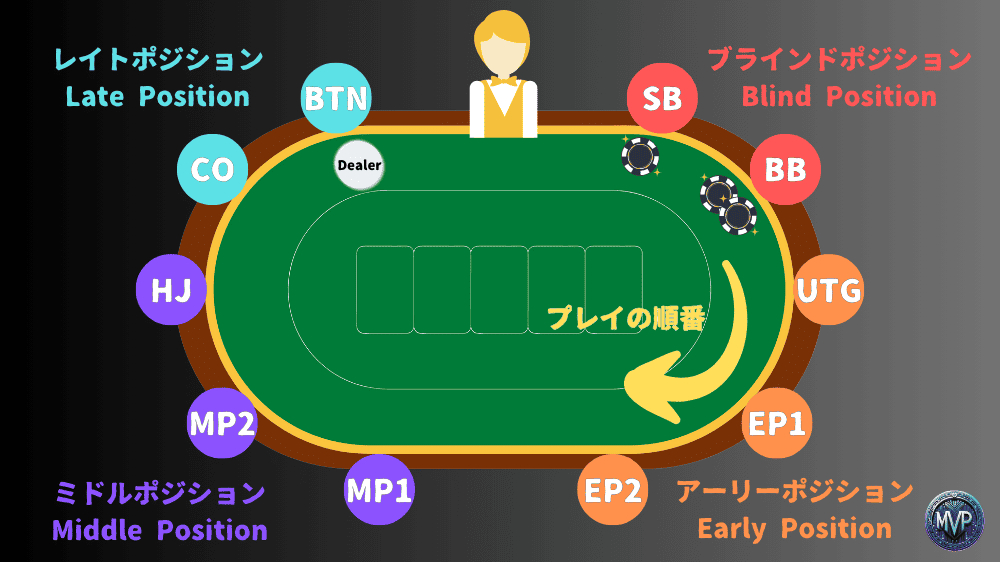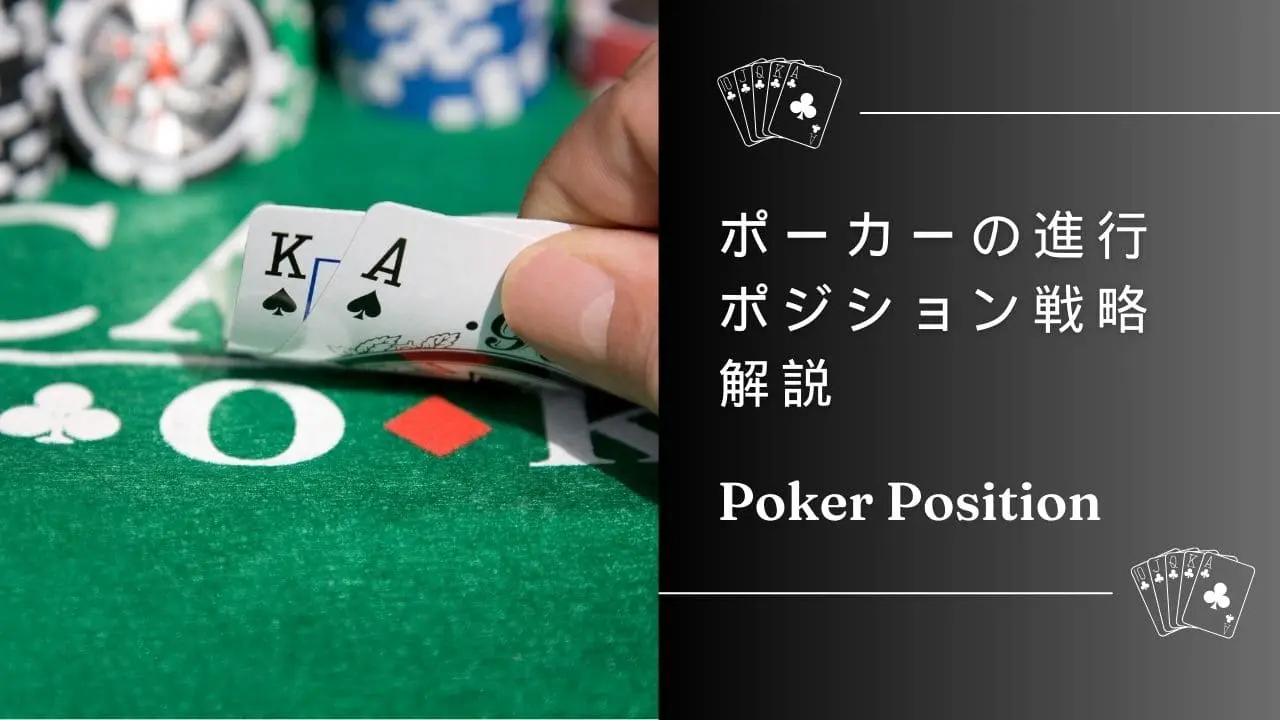One of the first things you need to grasp to become a successful poker player is the importance of position. In poker, “position” refers to your seat at the table and the order in which you act. Since position influences the amount of information you receive and the strategic options available, it directly affects your chances of winning. For beginners, simply understanding position can drastically change how they perceive the game and help them improve their results. This article will explain how position affects play and the strategic differences between different positions in an easy-to-understand manner.
Poker Position Overview

Poker games are typically played with up to 10 players at a table. While online poker and mobile apps may have varying table sizes, we will focus on the standard 10-player format commonly used in tournaments.
List of Positions in a 10-Player Poker Game:
- BTN (Button / Dealer) – The most advantageous position, as you act last in post-flop betting rounds, allowing you to make informed decisions based on other players’ actions.
- SB (Small Blind) – A forced bet position that acts second in pre-flop play and first in post-flop rounds, making it a difficult position to play profitably.
- BB (Big Blind) – Another forced bet position, but with the advantage of acting last pre-flop.
- UTG (Under the Gun) – The first player to act pre-flop, making it one of the toughest positions requiring tight play.
- EP (Early Position) – Slightly better than UTG but still a position where caution is needed.
- MP (Middle Position) – A more balanced position with some available information but still requires careful hand selection.
- HJ (Hijack) – A late position allowing more aggressive plays.
- CO (Cutoff) – The second-best position after the button, enabling aggressive betting and stealing blinds efficiently.
How Position Influences Play
The Information Advantage
Your position determines how much information you have when making decisions. Comparing late and early positions helps illustrate this concept:
- Late Position (BTN, CO) – Since you act after most players, you can gauge their intentions before deciding, making it easier to control the pot and bluff effectively.
- Early Position (UTG, EP) – Acting first means you lack information about opponents’ hands, making it a risky spot that requires careful decision-making.
Strategic Implications
- Early Position Strategy – Play very tight, choosing only premium hands like AA, KK, QQ, and AK. Avoid weak hands that could put you at a disadvantage.
- Late Position Strategy – Take advantage of your information advantage by playing a wider range of hands and using position to bluff or steal blinds.
Why Position Matters for Win Rates
Understanding position helps you avoid unnecessary losses, manage chips efficiently, and capitalize on strategic advantages. Since poker is a long-term game, effective chip management and maximizing position benefits lead to consistent profits. Positions like BTN and CO allow you to be more aggressive, accumulating chips more effectively over time.
Detailed Analysis of Each Position

BTN (Button / Dealer Position)
Characteristics:
- Acts last post-flop, providing the most strategic control.
- Allows for the widest hand range, including speculative hands.
- Retains an advantage throughout the hand.
Strategy:
- Play a wide range of hands, including suited connectors and weaker Broadway cards.
- Utilize bluffs to take down pots when opponents show weakness.
- Control pot size effectively with well-calibrated bet sizing.
CO (Cutoff)
Characteristics:
- Second-best position at the table, providing flexibility and aggression.
- Well-suited for stealing blinds and controlling hand dynamics.
Strategy:
- Attack blinds aggressively, especially if they are passive players.
- Use position to put pressure on mid-position players.
- Adapt based on the button’s tendencies, playing tighter if the BTN is aggressive.

SB (Small Blind)
Characteristics:
- Forced to post a small bet before seeing cards.
- Acts first post-flop, making it the hardest position to play profitably.
Strategy:
- Play tightly to minimize losses from a disadvantaged position.
- Use re-raises selectively to prevent late-position players from stealing blinds.
- Exercise caution post-flop, as acting first makes it harder to extract value from hands.
BB (Big Blind)
Characteristics:
- Must post a full blind, giving automatic investment in the pot.
- Has the advantage of closing pre-flop action.
Strategy:
- Defend the big blind against frequent steals, especially from late position players.
- Utilize speculative hands when pot odds justify a call.
- Play aggressively against weak continuation bets from opponents.

UTG (Under the Gun)
Characteristics:
- Acts first pre-flop, giving no information about opponents’ holdings.
- Most susceptible to re-raises from other players.
Strategy:
- Stick to only the strongest hands (AA, KK, QQ, AK suited).
- Fold weaker hands to avoid unnecessary risks.
- Preserve chips for better strategic opportunities in later hands.
EP (Early Position)
Characteristics:
- Slightly better than UTG but still requires caution.
- Limited information, necessitating a tight hand selection.
Strategy:
- Avoid speculative hands unless in a multiway pot with good odds.
- Adjust decisions based on opponents’ tendencies and table dynamics.

MP (Middle Position)
Characteristics:
- More information than early positions but still not as advantageous as late positions.
Strategy:
- Begin loosening hand selection slightly compared to early positions.
- Look for opportunities to exploit weaker players acting after you.
HJ (Hijack)
Characteristics:
- One of the first late positions, allowing more aggressive play.
- Positioned to challenge steals from the CO and BTN.
Strategy:
- Open with a wider range of hands compared to earlier positions.
- Re-raise selectively to prevent BTN and CO from controlling the game.
Summary
Simply knowing about position is not enough—you need to integrate this knowledge into actual gameplay. Understanding position-specific hand selection and playstyle is a crucial step toward poker success.
Key Takeaways
- Early position demands tight, conservative play to minimize risks.
- Middle position offers more flexibility but still requires careful hand selection.
- Late position is the most profitable, allowing for aggressive and strategic plays.
By mastering positional awareness and adjusting your strategy accordingly, you can significantly improve your poker performance and long-term success.


